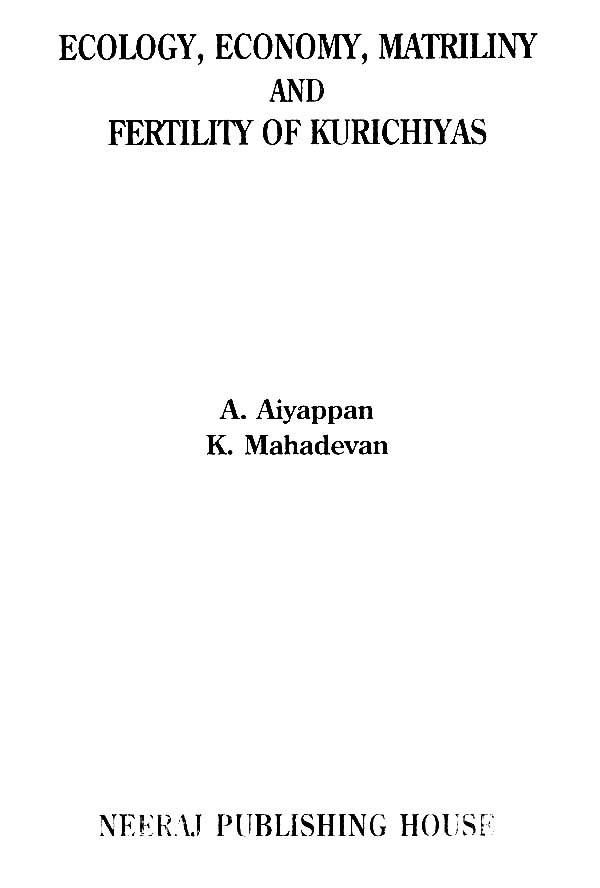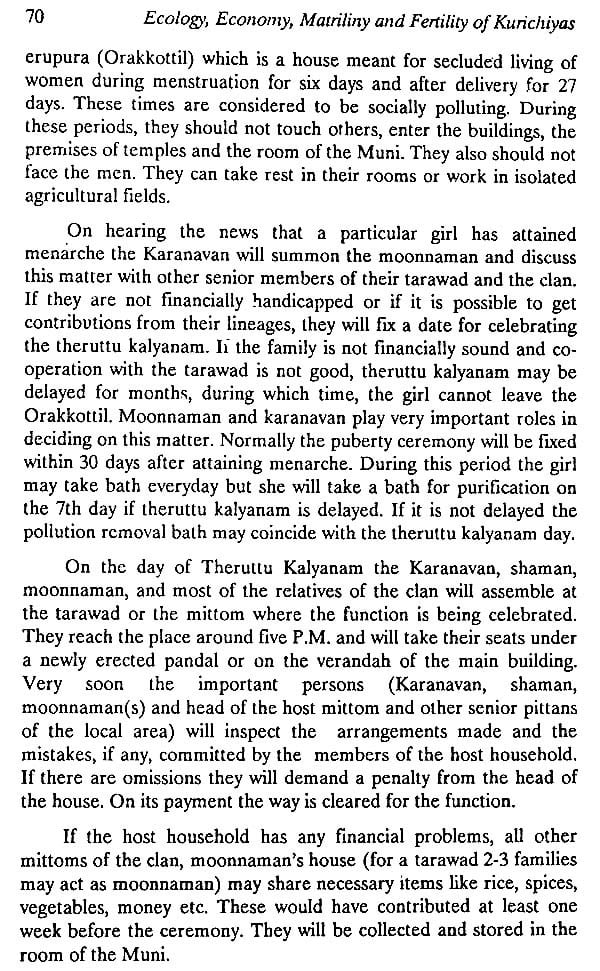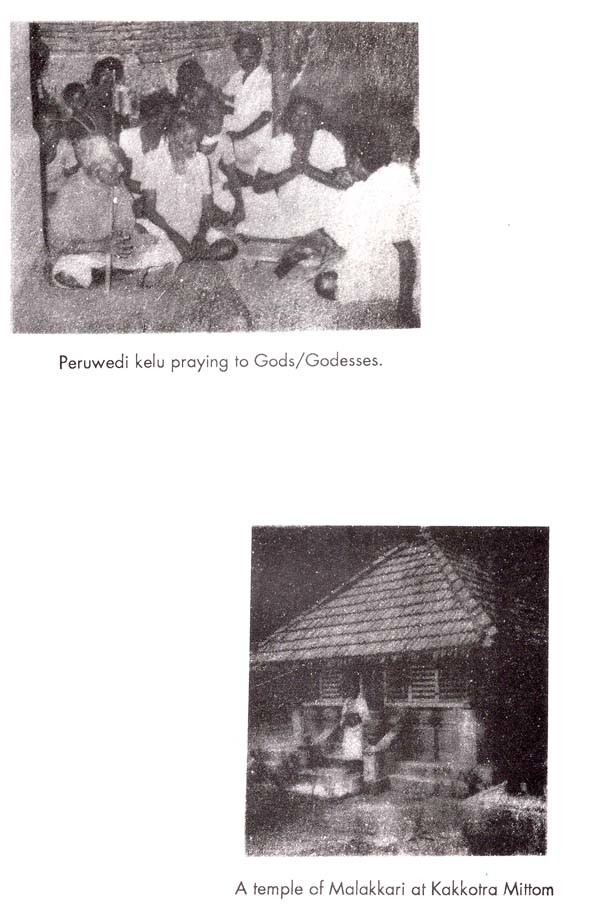About the Book The book has been evolved on the basis of long term. research spread over 3-4 decades jointly by Prof A Aiyappan and Prof. K. Mahadevan. It is focusing on a classical and rare community which characterizes several fascinating features. No other Tribal Community in the world has several complex, colorful and rare features like that of the Kurichiyas. They include the universal practice of Matriliny, extensive and massive joint family, which. have become rare in the world today. Their elderly persons live up to 100 years with good health and are able to work. They have no major health problems unlike the educated and modern elites like those even in the developed countries. It is a valuable lesson for experts on health and for people in general. Women and elderly, live happily without discrimination and neglect. Infant mortality is very less, thanks to their wonderful personal hygiene and environmental sanitation. Their staple food of raga and wild meat make their food balanced and healthy too. It is a mystery, how this illiterate tribe follows many scientific life styles with least problems of all kinds.
Poverty and beggary are unknown to them. Of course, their economic self-sufficiency has reduced due to exploitation in recent times. Their collective farming, joint ownership of landed and other property, equitable distribution of food, and all other facilities, besides cooperative work in the field, forest and rearing of animals and hunting too make them socialistic. Of course, they are highly religious people believing in primitive religion. Their honesty and integrity are well known and rare. modern society. They have social and economic security for one and all.
There are ten chapters of this book. Among them matrilineal and family organization, largest joint family, and commune life, constitute the classical features of this tribe.. Their prolonged longevity, healthy life, better status for women are fascinating features for emulation even by the modern people. Their ecology, economy, and social change besides the high fertility are lessons for development administrators and planners for promoting new models of development without ecological disaster. Lastly the experiences of successful tribal rehabilitation. given here make a new viable model icing it elsewhere.
About the Authors Professor A. Alyappan was one of the top three Anthropologists of India. Unlike other anthropologists, he had a rare distinction of contributing several original and valuable papers in almost all the branches of anthropology They have been listed in a felicitation volume edited by Sri B.N. Nayar and published by Thompson Press. He again had the rare distinction of being the first Indian Director of the Madras Museum. He was a pioneer in establishing two tribal research centers in India and was the first honorary director of these institutions at Bhubaneswar and Calicut. He was the founder Professor of the department of Anthropology of Utkal University. He was also a UGC Professor in Andhra University. As a Professor he guided over a dozen PhDs., and many of them are professors in different universities in India today. He also became the Vice-Chancellor of Kerala University. He was a student for his Ph.D., in Anthropology at the London School of Economics and had the privilege of being his student of the great professors like B. Malinowski and Raymond Firth.
Prof. Dr. Kuttan Mahadevan is currently Chairman. of an International Centre for Development Studies. Formerly he was visiting professor (Fulbright) in Michigan, Eastwest and Columbia universities in the USA, University of Alberta in Canada, university of Addis Ababa in Africa, and Punjab university. He was principal, Dean and Professor in S.V. University for 23 years. He was honored in Great Hall of China in 1997, in Tamil Nadu by Govt in 1994 and given Millennium certificate for being the best professor in S.V. University, at Tirupati in 2000. He was given Man of the year award in the world on social sciences by American Biographical Institute and so on. His Holistic Development Model, theories on Life Affecting Variables, Variables Affecting Reproductive Health, Empowerment of Women, 5 classic books on all the great personalities of India, 10 books on all the Asian countries, 35 books on health, population sciences and development are a record in the world.
Preface The book titled "Ecology, Economy, Matriliny and Fertility of Kurichiyas, is an anthropological study of a tribe living in Weaned plateau of Western Ghat region in Kerala state, India. Kurichiyas are an exceptionally interesting tribe possessing a complex culture, economic self sufficiency and following a commune type of living. Their massive joint families maintain a matrilineal heritage. They are mainly agriculturists, herders and hunters. Co-operative farming is common among them; equality in owning property, all amenities of life, space and food etc. form a fascinating feature of this tribe. They form a socialistic tribal community, and they have been following these principles for the past several centuries even before Karl Marx wrote Das Capital. They are highly religious and follow an animistic form of religion. They are a wonderfully hygienic community and their diet is exceptionally nutritious. Consequently, their elderly men and women live up to 100 years and also lead a healthy and happy life.
On account of the matrilineal heritage the Kurichiya women enjoy an enviable position. They generally had a very high fertility in the past but now it is slowly declining. Surprisingly, their infant mortality is very low, thanks to several factors including prolonged breastfeeding, regular use of raga products in the diet, exceptionally good personal hygiene and excellent sanitation. It is remarkable to see how this illiterate community imbibed such modern value system which is rare in the rest of India, particularly even among the educated rural people. Girls, old women, widows, and old men have no problem and face no discrimination. In fact elderly women and men are respected in their community and enjoy all facilities. They are exceptionally healthy and rarely suffer from hypertension, cardiac problems, rheumatism etc. They have good vision and hearing and are able to work and walk even at the age of 90 or 100. They have a prolonged longevity than any other population in Kerala.
Introduction The Kurichiyas of Kerala state in Southern India are now the only Indian community outside Assam that continued to follow the matrilineal system of descent. The matrilineal Nayars of Kerala still described in text books as a classical example of matrilineal have long ago given it up. However, matrilineal survived among the Kurichiyas partly on account of their deep-rooted conservatism and isolation in Weaned plateau. Till 1940s Weaned remained as a forest land interspersed with limited habitation of mostly tribal’s. The people of Kerala as a whole are religious and conservative-even the communists here go to the temples and pray-but no other group can equal the Kurichiyas in their religiousness. The Kurichiyas have history of their own but have a few legends from which we have tried to glean out their heroes and the past. They were the first migrants into the Weaned hills from the adjoining plain regions through the Kuntimadi and Peria passes and settled down in the Western regions of Weaned as the first farmers of the region. The autochthones of Weaned, the Panamas, were simple food-gatherers, both physically and culturally different from the Kurichiyas and had their own dialect. The Panamas were treated as untouchables by the Kurichiyas; the Panamas would pollute the Kurichiyas even from a distance of thirty feet. The Kurichiyas regard themselves as Kari Nayar, a sub division of the Nayar caste. Weaned became a part of the territories of the Nayar chieftains of North Malabar and when some of their Nayar subjects were assigned lands in Weaned, the Kurichiyas became their tenants. In the latter capacity the Kurichiyas had to make periodical payments to the Nayar landlords and perform various duties for them. In contrast to the landlords in the plains, the Weaned landlords were not oppressive. During mid eighteenth century, Weaned came under the rule of Muslim sultans of Mysore who were replaced by the British. During the first decade of the 19th century, the Kurichiyas were involved in the skirmish, which the Raja of Kottayam, the traditional overlord of Weaned had with the British.
**Contents and Sample Pages**


















